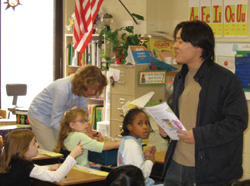
A Deeper Insight
Members of the Peoria Chinese Association recognized China’s importance in our country when they welcomed five teachers— three female and two male—from China at the Greater Peoria Regional Airport on Sunday, August 11th, 2007. Sun Junfang, a teacher for nineteen years, was among the instructors who traveled from Beijing and who will teach the Mandarin Chinese language and culture to District 150 students over the next two years.
“The world is becoming smaller, and there are growing interactions between China and America,” she says. “Learning Chinese doesn’t only mean that students can communicate with a different language, but it also means that they can have a deeper insight of China’s five thousand years of civilization.” Sun will teach grades five through eight at Von Steuben Middle School and kindergarten through third grade at Hines. Other schools participating in the program include Richwoods and Woodruff high schools, Lindbergh Middle School, and Charter Oak Primary School.
Although some District 150 students are not meeting current testing standards, board member Debbie Wolfmeyer believes that those students who are excelling need the extra challenges learning Chinese will bring. Overall, 64 teachers from China will teach their native language in New York, Wisconsin, Ohio and other areas across the United States.
Song Chao joins Sun in her teaching efforts as the Chinese language instructor of kindergarten through fourth grade at Charter Oak Primary School. “We are the first group of teachers to come to District 150,” he says. “Almost all of the students are learning Chinese. Grades one through four have mandatory Chinese classes two times a week, and even kindergarteners are being introduced to the language.” Lessons began August 20th.
 A Different Rhythm
A Different Rhythm
The Chinese lessons Song gives his third grade students at Charter Oak are filled with laughter, energy and enthusiasm. At the start of class, students sing a welcome song in Chinese that is followed by a brief martial arts lesson. The students stand beside their desks in martial arts form and repeat the Chinese commands Song gives them. Students then spend the majority of class time in groups of four or five. One group exercise requires the third graders to write the symbols for Chinese numbers twenty through ninety, eleven through nineteen, and twenty-one through seventy-one. Group work ends each time Song sings a familiar Chinese verse, and students scramble back to their desks. “Ah, this is too easy for you!” Song teases, as the students rattle off their answers.
Song places heavy emphasis on teamwork, respecting classmates and their ideas and supporting one another’s efforts, while teacher’s helpers, small prizes for students and positive feedback during songs, games and group work encourage class participation. “Very good job. I like your voice!” he says to a student during the closing song. Finally, class ends, and with a friendly wave goodbye, Song wheels his cart filled with Chinese games and activities out the door until the next day’s lesson.
Digging Up Treasure
The many facets of the Chinese language provide plenty of opportunity for students to learn. However, like the students, Sun admits that she, too, is always learning. “We are both learners and teachers here,” she says. “Most of the teachers in our group are English teachers in China. We really cherish the chance to improve our own language ability.” Song is also grateful for the chance to improve his English and is excited to learn about the different American holidays. “We do not have Halloween in China,” says Song. “I am happy to be able to experience it for the first time.” Not only do the teachers learn about American culture, they learn about their own culture as well. “As we teach students Chinese language and culture, we begin to find a lot of treasures in our own civilization,” says Sun. “This exchange is really wonderful for both the students and ourselves.”
 Building Friendships
Building Friendships
In addition to the support Chinese teachers have received from central Illinois schools, students and parents have also responded positively to the Chinese language program. The program has helped teachers from China build special friendships with their students, both inside and outside the classroom. For instance, Sun’s students learned the Chinese word Huamei from their homeroom teacher. According to Sun, the word is a panda’s name in America and means the friendship between China and America. Hua represents China, and Mei represents America. Says Sun: “The students couldn’t wait to share the word with me. They were so happy to build up some kind of relationship with me and my culture. When I meet students in the hall, in the park, or in the supermarket, they are so happy and greet me in Chinese, and they are eager to introduce me to their parents.”
And parental support is a big part of what makes this program a success. According to Sun, many parents have told her that their children are excited about and fascinated with the Chinese language. “Many parents say their kids love me and my lesson,” says Sun. “Some of the parents say their kids shared with them everything they learned in the Chinese lesson.” Parents are also pleased with the speed at which their children are learning and are truly amazed by the fact that their children are able to speak short Chinese phrases fluently and tell them all about the Chinese way of life. “If you go into a library, you find information about China that is probably at least twenty years old,” Song says. “The Chinese language program and our teaching allows students to experience firsthand the culture of present-day China.”
Putting the Fun in Learning
Despite the evident excitement among students and their parents, Sun is also aware that learning a new language can be challenging for some students. She therefore takes steps to make her classes both fun and rewarding. Using teaching techniques such as singing songs, drawing pictures, using flashcards and engaging students in games, competitions and storytelling, Sun keeps her students active while interweaving culture with language.
 Closing the Gap
Closing the Gap
Perhaps one of the biggest advantages of the Chinese school program is that it helps bridge the gap between China and America both in terms of language and culture as well as economy. According to Sun, because of China’s greater presence in business, cultural exchange and tourism, China’s open policy is attracting more and more people from other countries. “The Chinese see this school program as a great opportunity to connect with Americans, and they don’t want to miss this chance,” says Song. Sun agrees and believes that the Chinese language and culture American students learn today will be of great value as they become older. “Just like the story I told the students,” says Sun, “the stones they pick up today may become gold tomorrow.”
And it appears many Americans feel the same. America’s link with China has proven beneficial in the workplace as well as in the classroom. With an eye for global expansion and in order to support manufacturing growth in Asia Pacific operations, Caterpillar, Inc. recently announced the opening of a component manufacturing campus in Wuxi, located in Jiangsu province in East China.
Caterpillar’s presence in Wuxi is not only helping to keep the company globally competitive, producing hydraulic hose assemblies since mid-2006 and assembling cabs for core Cat machines since early 2007, but its presence benefits the Chinese as well. Caterpillar provides machines to meet the needs of Chinese customers faced with emissions reduction requirements. Indeed, China’s ability to benefit from what Caterpillar’s Rich Lavin calls “the unparalleled value that comes with owning and operating Caterpillar machines and engines,” coupled with America’s opportunity to increase foreign language skills strikes up a parallelism that some educators and business owners might describe as Utopian. And with Caterpillar Chairman and CEO Jim Owens urging the United States and China to keep relations positive, it’s clear that foreign relations benefits encompass more than quality business and education. Whether teaching Chinese or strengthening the global economy, it’s about helping millions of people worldwide gain access to a higher standard of living. “Huamei! Huamei! Huamei!” Well, we aim to please. IBI

